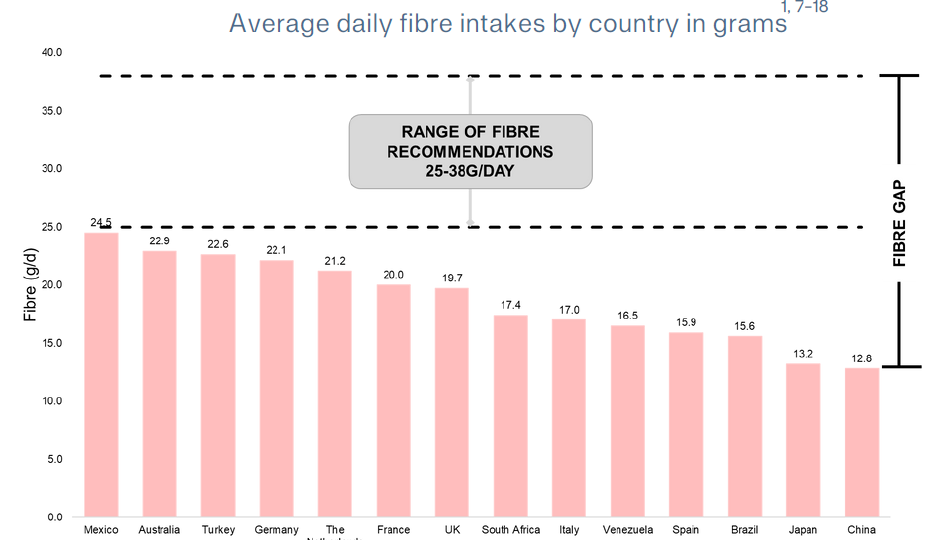You’re probably not consuming enough fibre!
According to the World Health Organization, adults should eat at least 25 grams of fibre per day – but the reality is that most people are not getting enough, and in many cases nowhere near enough.
It is perhaps then not a surprise that as many as 52% of consumers want to increase their fibre intake, as revealed by a survey by Tate & Lyle.1
Why consume fibre?
Fibre does so much more than simply promote healthy bowel function. Dietary fibres are carbohydrates that are resistant to human digestive enzymes: they pass through the stomach and small intestine and reach the large intestine without being digested. This means that they have a low caloric value, their impact on blood glucose is negligible, they help to prolong the feeling of fullness and they even support gut health.
By prolonging the feeling of fullness, fibre can help maintain a healthy body weight. In addition, fibre helps regulate blood cholesterol, glucose and insulin levels. In turn, this can help to manage and reduce the risk of developing illnesses such as diabetes and cardiovascular disease. Emerging research indicates that some fibres can also help the immune system function properly.
How to consume more fibre
Fruits, vegetables (legumes such as beans) and grains (cereals such as brown rice) are the most common sources of fibre. You should try to include a mix of these in your diet. This is because there are several types of fibres and many of them have specific benefits.
Getting enough fibre from fruits, vegetables and legumes alone can be a challenge, however. For example, you’d need to eat 8 servings of brown rice, 7 oranges or 25 servings of potatoes to achieve it – and that comes with a lot of calories.
But there are many other foods and drinks you can consume to boost your intake. For example, it’s becoming increasingly common to find products on the supermarket shelves that have been fortified with fibre, such as breakfast cereals, snack bars and yoghurts.
How to find fibre-fortified foods in the supermarket
| First of all, check the packaging for claims such as “source of fibre” and “high in fibre”. Manufacturers can only put these types of claim on the packaging if they contain a specified amount of fibre – though this amount varies by country and region. For example, in the EU, a product must contain at least 3 grams per 100g to be called a source of fibre, and 6 grams per 100g to be called high in fibre. | ||||
| The nutritional facts table can also help you make informed choices. It will show you the amount of dietary fibre in grams per serving, and what percentage of the recommended daily intake that amounts to. | ||||
| You can also take a look at the list of ingredients. Depending on local regulations, fibres may be listed using technical names, such as polydextrose, resistant maltodextrin, resistant corn starch, inulin, pectin, beta-glucans, and others, but they all are dietary fibres like those present in vegetables, fruits and grains. Resistant maltodextrin, for example, is a soluble fibre obtained from corn. | ||||
What role can food and drink manufacturers play to help people get enough fibre?
By fortifying food and drinks with fibre, manufacturers can help consumers achieve the recommended intake and enjoy the various health benefits that brings. We work closely with our customers to help them do this, without compromising on taste.
Find out more about our expertise in fibre fortification here!
Sources:
1, Tate & Lyle proprietary research, Fibre AAU 2016, 11 countries, 8,800 consumers.
France: Partula et al., “Associations between consumption of dietary fibers and the risk of cardiovascular diseases, cancers, type 2 diabetes, and mortality in the prospective NutriNet-Santé cohort”, The American Journal of Clinical Nutrition, 112(1), July 2020, pp. 195–207
Italy: Mertens, E., et al., “Geographic and socioeconomic diversity of food and nutrient intakes: a comparison of four European countries”, European Journal of Nutrition, 58(4), 2019, pp. 1475-93.
Spain, UK, Greece, Germany: Murphy et al., “Dietary Fibre Intake and Risks of Cancers of the Colon and Rectum in the European Prospective Investigation into Cancer and Nutrition (EPIC)”, PLoS One, 7(6): e39361, 2012.
Netherlands, US: Auestad et al., “Contribution of Food Groups to Energy and Nutrient Intakes in Five Developed Countries, Nutrients, 8;7(6), June 2015, pp. 4593-618.
Australia: Fayet-Moore, F. et al., “Dietary Fibre Intake in Australia. Paper I: Associations with Demographic, Socio-Economic, and Anthropometric Factors”, Nutrients, 10(5), 599, 2018.
China: Wang HJ et al., “Trends in dietary fiber intake in Chinese aged 45 years and above, 1991-2011”, European Journal of Clinical Nutrition, 68(5), May 2014, pp. 619-22.
Japan: Katagiri, R. et al., “Dietary fiber intake and total and cause-specific mortality: the Japan Public Health Center-based prospective study”, American Journal of Clinical Nutrition, 111(5), 2020, pp. 1027-35.
Mexico: Flores, M. et al., “Dietary patterns in Mexican adults are associated with risk of being overweight or obese”, Journal of Nutrition, 140(10), October 2010.
Chile: Dehghan, M. et al., “Relative validity of an FFQ to estimate daily food and nutrient intakes for Chilean adults”, Public Health Nutrition, 16(10), October 2013, pp. 1782-8.
Brazil: Sardinha, A.N. et al., “Dietary sources of fiber intake in Brazil,” Appetite, 79, 2014, pp. 134-8.



